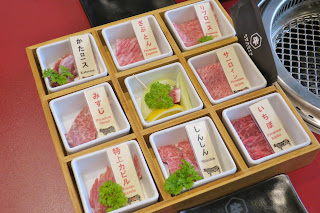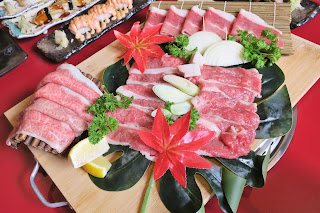It
was good to be back at Wan Li, the Chinese Restaurant at Renaissance Johor Baru,
for a preview of their traditional handcrafted mooncakes and snow skin
mooncakes.
It
was also a pleasure to meet with hotel General Manager, Kanit Sangmookda, and
to tell him that it has almost become an annual tradition for us to enjoy a
preview of the lovely mooncakes by Wan Li at each Mid-Autumn Festival.
A charming display in the Mid-Autumn Festival
theme at the Mooncake Counter in the hotel lobby
Once
again, the restaurant will present 16 varieties of handcrafted mooncakes, both
traditional baked and snow skin mooncakes, available from the Mooncake Counter,
conveniently located in the hotel lobby, from now till 10 September 2022.
In
the weeks prior to the Mid-Autumn Festival, the Chinese have a tradition of
presenting each other with quality mooncakes as an expression of affection and
auspicious wishes.
This
is because the Mid-Autumn Festival is another reason for family reunions over a
grand feast and to enjoy eating mooncakes with sips of quality Chinese tea, while
the children have fun exploring the moonlit darkness in the garden by the light
of their lanterns.
Traditional baked mooncake stuffed with
Jade Custard, is among the popular choices
of Wan Li mooncakes
With
its central location in the hotel lobby, the Mooncake Counter drew immediate
attention, with its décor in a charming Mid-Autumn Festival theme that
showcased a variety of traditional baked mooncakes as well as snow skin
mooncakes, along with a range of quality Chinese teas, recommended to pair with
the mooncakes.
This
year, the elegant gift boxes for mooncakes from Wan Li are designed in Tiffany
Blue and are used along with similar gift boxes designed in a soothing shade of
violet. Chef Pei Shi presenting her
demo in making traditional
handcrafted mooncake
At
Wan Li Chinese Restaurant, all eyes were on Chef De Partie, Lim Pei Shi, as she
presented a demonstration of a handcrafted mooncake, stuffed with lotus paste and
a single egg yolk.
I
am familiar with Chef Pei Shi and have tasted the traditional baked mooncakes
and snow skin mooncakes from Wan Li, filled with fresh, quality, natural ingredients
and flavours, that were made without preservatives.
It
was also good to see a display of the various ingredients that went into the
stuffing for their range of traditional mooncakes.
As
I listened to her commentary for the step-by-step demo, I was pleased to note
that this young lady has gained much confidence, not only in public-speaking
but also in her demonstration skills while she and her demo were the focus for a
group of eager photographers and videographers.
When
Chef Pei Shi had carefully sealed the pastry and its filling into the
traditional wooden mooncake mould, there was a tiny pause as she searched for a
firm space on the counter on which to knock the mould against – once on its
left and once on its right – before a final knock on the upper part of the
mould, to release the neatly shaped mooncake from its wooden mould.
Some of the ingredients in the stuffing for
traditional handcrafted mooncakes
These
wooden moulds are custom-made for the Renaissance, designed with a distinct
identity of a capital letter ‘R’ for Renaissance.
I
thought this demo was both informative and educational, one that offered a better
appreciation for the culture and tradition of making and sharing of mooncakes
with family and friends, in a range of delicious delicacies that are now available
in Halal versions for all Malaysians to enjoy.
I
can recognise the square-shaped baked mooncake which is stuffed with Assorted
Fruits & Nuts while the round-shaped baked mooncake is filled with fine
quality, Pure Lotus Paste with a sprinkle of toasted melon seeds or kuaci.

A platter of Wan Li snow skin mooncakes
The
Lotus Paste and Green Tea Paste mooncakes come with a choice of Single or
Double yolks. Other popular choices of traditional baked mooncakes are Red Bean
and Jade Custard, the jade green derived from the natural flavour of fragrant pandan
leaves.
Their
creative range of snow skin mooncakes include Golden Peach Truffle and
Blueberry Truffle along with Orange Truffle, Strawberry Truffle, Green Tea
Matcha Truffle, Chocolate Crunchy Pearl, Taro Paste Truffle and Peppermint
Chocolate Truffle, as well as premium snow skin mooncake filled with Durian Truffle.
To
better appreciate the fragrant taste and smooth texture of each flavour of
these delicate pastel-coloured mooncakes, snow skin mooncakes are best savoured
chilled.A range of quality Chinese tea recommended
to pair with the traditional mooncakes
A
set of eight Wan Li snow skin mooncakes within a gift box is priced at RM128
nett, a set of four baked mooncakes is priced at RM128 nett while snow skin
mooncakes stuffed with Durian Truffle is priced at RM148 nett in a box of
eight.
Enjoy
attractive promotional deals for the purchase of mooncakes in a single receipt:
10% discount for early-bird buys from now till August 11, 15% discount for
purchases above 25 boxes and 25% discount for purchases of above 100 boxes.
Club Renaissance JB members will enjoy 15%
discount.
Small slices of a range of Wan Li
traditional baked mooncakes for our tasting
For
advance orders, please call, Tel: +607 – 381 3388 or send email to:
henry.lee@renaissancehotels.com
Enquiries
and orders may be sent by WhatsApp to Tel: +6012 – 771 9056 from 11am to 9pm.
Handcrafted
mooncakes by Wan Li at Renaissance Johor Baru are also available on Shopee,
Lazada and Oddle (https://wanlirestaurant.oddle.me/en_MY/) platform.
Wan
Li Chinese Restaurant (Halal) is on the lobby level of Renaissance Johor Baru,
at No. 2 Jalan Permas 11, Bandar Baru Permas Jaya, 81750 Johor Baru, Johor.
For
more info, visit website: www.wanlichineserestaurant.com and sign up for exclusive updates and to enjoy
special deals.










































